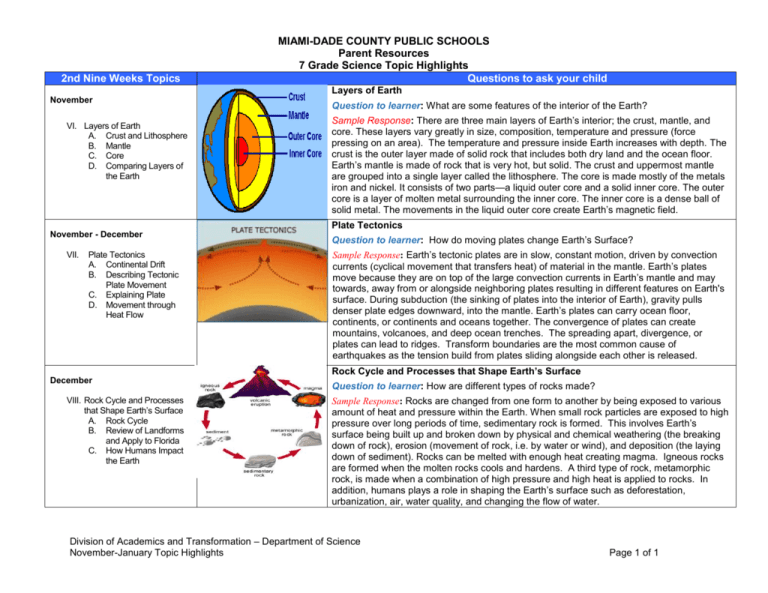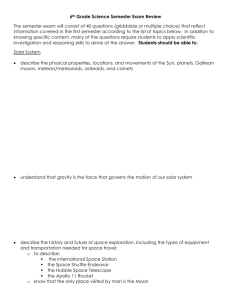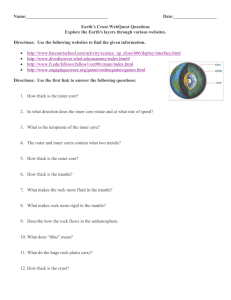Grade Seven - Science - Miami
advertisement

2nd Nine Weeks Topics MIAMI-DADE COUNTY PUBLIC SCHOOLS Parent Resources 7 Grade Science Topic Highlights Questions to ask your child Layers of Earth November VI. Layers of Earth A. Crust and Lithosphere B. Mantle C. Core D. Comparing Layers of the Earth Question to learner: What are some features of the interior of the Earth? Sample Response: There are three main layers of Earth’s interior; the crust, mantle, and core. These layers vary greatly in size, composition, temperature and pressure (force pressing on an area). The temperature and pressure inside Earth increases with depth. The crust is the outer layer made of solid rock that includes both dry land and the ocean floor. Earth’s mantle is made of rock that is very hot, but solid. The crust and uppermost mantle are grouped into a single layer called the lithosphere. The core is made mostly of the metals iron and nickel. It consists of two parts—a liquid outer core and a solid inner core. The outer core is a layer of molten metal surrounding the inner core. The inner core is a dense ball of solid metal. The movements in the liquid outer core create Earth’s magnetic field. Plate Tectonics November - December VII. Plate Tectonics A. Continental Drift B. Describing Tectonic Plate Movement C. Explaining Plate D. Movement through Heat Flow Question to learner: How do moving plates change Earth’s Surface? Sample Response: Earth’s tectonic plates are in slow, constant motion, driven by convection currents (cyclical movement that transfers heat) of material in the mantle. Earth’s plates move because they are on top of the large convection currents in Earth’s mantle and may towards, away from or alongside neighboring plates resulting in different features on Earth's surface. During subduction (the sinking of plates into the interior of Earth), gravity pulls denser plate edges downward, into the mantle. Earth’s plates can carry ocean floor, continents, or continents and oceans together. The convergence of plates can create mountains, volcanoes, and deep ocean trenches. The spreading apart, divergence, or plates can lead to ridges. Transform boundaries are the most common cause of earthquakes as the tension build from plates sliding alongside each other is released. Rock Cycle and Processes that Shape Earth’s Surface December VIII. Rock Cycle and Processes that Shape Earth’s Surface A. Rock Cycle B. Review of Landforms and Apply to Florida C. How Humans Impact the Earth Question to learner: How are different types of rocks made? Sample Response: Rocks are changed from one form to another by being exposed to various amount of heat and pressure within the Earth. When small rock particles are exposed to high pressure over long periods of time, sedimentary rock is formed. This involves Earth’s surface being built up and broken down by physical and chemical weathering (the breaking down of rock), erosion (movement of rock, i.e. by water or wind), and deposition (the laying down of sediment). Rocks can be melted with enough heat creating magma. Igneous rocks are formed when the molten rocks cools and hardens. A third type of rock, metamorphic rock, is made when a combination of high pressure and high heat is applied to rocks. In addition, humans plays a role in shaping the Earth’s surface such as deforestation, urbanization, air, water quality, and changing the flow of water. Division of Academics and Transformation – Department of Science November-January Topic Highlights Page 1 of 1 MIAMI-DADE COUNTY PUBLIC SCHOOLS Parent Resources 7 Grade Science Topic Highlights Age of Earth/Geological Time January IX. Age of Earth/ Geological Time A. Measuring the Age of the Earth B. Evidence of Changes to Earth Question to learner: How do scientists study Earth’s past? Sample Response: The Earth has evolved over geologic time (many millions of years) due to natural processes. Current methods for measuring the age of Earth and parts of the Earth include the Law of Superposition and radioactive dating. According to the law of superposition, in horizontal sedimentary rock layers the oldest layer is at the bottom. Each higher layer is younger than the layers below it since rock layers and build by new sediment adding to the lower layers. This method doesn't provide an exact or numerical age. Instead the Law of Superposition is used to determine relative ages of a group of rocks such as "younger" or older". Radioactive dating uses a chemical analysis of rocks to determine an approximate numerical age. Division of Academics and Transformation – Department of Science November-January Topic Highlights Page 1 of 1







